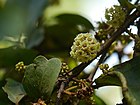Note: This is a project under development. The articles on this wiki are just being initiated and broadly incomplete. You can Help creating new pages.
Anogeissus latifolia - Dhava
Anogeissus latifolia is a small to medium-sized deciduous tree. It grows up to 20 metres tall. The bole can be unbranched for up to 15 metres. The tree is often harvested for its gum and tannins. It also yields a good quality wood and is planted in soil stabilization programmes.
Contents
[hide]- 1 Uses
- 2 Parts Used
- 3 Chemical Composition
- 4 Common names
- 5 Properties
- 6 Habit
- 7 Identification
- 8 List of Ayurvedic medicine in which the herb is used
- 9 Where to get the saplings
- 10 Mode of Propagation
- 11 How to plant/cultivate
- 12 Commonly seen growing in areas
- 13 Photo Gallery
- 14 References
- 15 External Links
Uses
Wound healing, Skin diseases, Diabetes, Anaemia, Hemorrhoids, Erisipelas, Piles[1][2]
Food
Dhava can be used in Food. Fried gum is used in preparation of ladoos (a sweet food item)[3].
Parts Used
Chemical Composition
The leaves, bark and heartwood yield quinic and shikmik acids; leaves contain gallotannin (90–95% of the tannins). The young leaves and shoots contain 50% tannins (dry basis). The bark contains 12–18% tannins. Heartwood contains gallic acid, ellagic acid, its derivatives, quercetin andmyricetin.[4]
Common names
| Language | Common name |
|---|---|
| Kannada | Dhinduga, Dindaga, Dindlu |
| Hindi | Dhau, Dhawda, Dohu |
| Malayalam | Malakanniram, Vellanaga |
| Tamil | Vellai-nagai, Ekariyamaram, Vellainakam |
| Telugu | Chirumaanu, Sirimaanu, Thirumaanu |
| Marathi | NA |
| Gujarathi | NA |
| Punjabi | NA |
| Kashmiri | NA |
| Sanskrit | Dhava, Dridhataru, Madhuratvacha, Nanditaru, Pishachavriksha, Shushkanga |
| English | Dhawa, Button tree |
Properties
Reference: Dravya - Substance, Rasa - Taste, Guna - Qualities, Veerya - Potency, Vipaka - Post-digesion effect, Karma - Pharmacological activity, Prabhava - Therepeutics.
Dravya
Rasa
Kashaya (Astringent)
Guna
Laghu (Light), Rooksha (Dry)
Veerya
Sheeta (cold)
Vipaka
Katu (Pungent)
Karma
Pitta, Kapha
Prabhava
Nutritional components
Dhava Contains the Following nutritional components like - Vitamin-A and C; Calcium, Iron, Phosphorus, Potassium, Sodium, Zinc[3]
Habit
Identification
Leaf
| Kind | Shape | Feature |
|---|---|---|
| Simple | Opposite or sometimes alternate | Estipulate; petiole 5-15 mm, slender, grooved above, glabrous; lamina 2.5-18 x 1.7-9 cm, elliptic, elliptic-oblong, suborbicular, or oblong-obovate |
Flower
| Type | Size | Color and composition | Stamen | More information |
|---|---|---|---|---|
| Bisexual | Axillary globose heads | Pale yellow | 10 | Peduncle puberulous; pedicel reduced or absent; calyx tube 2 winged, 3-5.5 mm long, produced above the ovary, villous inside, teeth 5, ovate-triangular. Flowering from August to January |
Fruit
| Type | Size | Mass | Appearance | Seeds | More information |
|---|---|---|---|---|---|
| A drupe | 6 - 8 mm across | Greenish-yellow, compressed, puberulous, circular; wings 2, margin entire or slightly undulate, beaked; seed one, obovate. | Fruiting from August to January |
Other features
List of Ayurvedic medicine in which the herb is used
Ayaskriti, Asanadi kashayam, Nyagrodadi churna, Bala oil[7]
Where to get the saplings
Mode of Propagation
How to plant/cultivate
Fruits should be collected only when they are fully ripe as immature seeds fail to germinate. The ripe fruits are collected from the trees, dried in the sun and then stored. Generally seed viability is low but increases after very dry seasons. Seed germination is increased by a 3-min hot water seed treatment. Seed storage in metal tins or polythene containers is the best. There are 105 000-125 000 seeds /kg[8]. Dhava is available through March to Septemebr[3].
Commonly seen growing in areas
Photo Gallery
References
- Jump up ↑ Uses
- ↑ Jump up to: 2.0 2.1 ”Karnataka Medicinal Plants Volume-3” by Dr.M. R. Gurudeva, Page No.579, Published by Divyachandra Prakashana, #6/7, Kaalika Soudha, Balepete cross, Bengaluru
- ↑ Jump up to: 3.0 3.1 3.2 "Forest food for Northern region of Western Ghats" by Dr. Mandar N. Datar and Dr. Anuradha S. Upadhye, Page No.25, Published by Maharashtra Association for the Cultivation of Science (MACS) Agharkar Research Institute, Gopal Ganesh Agarkar Road, Pune
- Jump up ↑ Chemical composition
- Jump up ↑ Vernacular names
- Jump up ↑ Botonic description
- Jump up ↑ Ayurvedic preparations
- Jump up ↑ Cultivation details
External Links
- Ayurvedic Herbs known to be helpful to treat Wound healing
- Ayurvedic Herbs known to be helpful to treat Skin diseases
- Ayurvedic Herbs known to be helpful to treat Diabetes
- Ayurvedic Herbs known to be helpful to treat Anaemia
- Ayurvedic Herbs known to be helpful to treat Hemorrhoids
- Ayurvedic Herbs known to be helpful to treat Erisipelas
- Ayurvedic Herbs known to be helpful to treat Piles
- Herbs with Bark used in medicine
- Herbs with Gum used in medicine
- Herbs with Heartwood used in medicine
- Herbs with common name in Kannada
- Herbs with common name in Hindi
- Herbs with common name in Malayalam
- Herbs with common name in Tamil
- Herbs with common name in Telugu
- Herbs with common name in Sanskrit
- Herbs with common name in English
- Habit - Tree
- Index of Plants which can be propagated by Seeds
- Index of Plants which can be propagated by Cuttings
- Herbs that are commonly seen in the region of Tropical area
- Herbs
- Plants of western ghats
- Combretaceae






